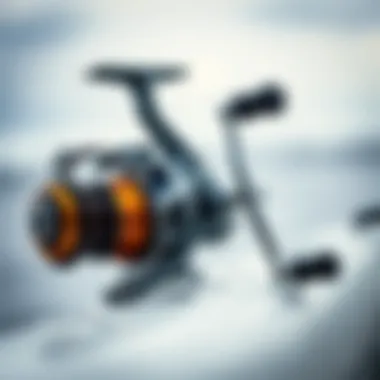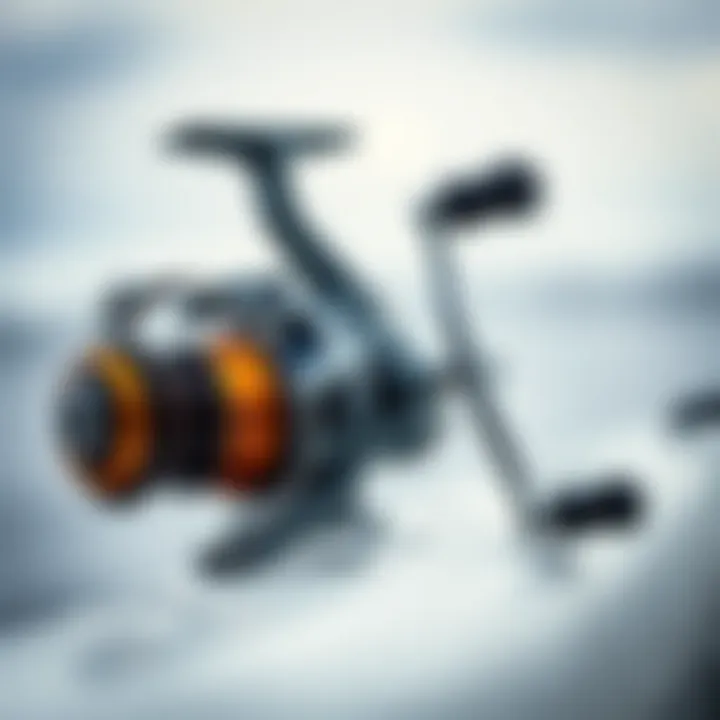Choosing the Right Reel Size for Surf Fishing


Intro
Choosing the right size of surf fishing reel is more than just a matter of personal preference. It is crucial for achieving success while casting from the beach, where understanding the nuances of tackle can significantly affect your overall experience. With vast beaches and excellent fishing opportunities, there's a fine line between landing that trophy catch and a frustrating day spent reeling in empty hooks. This article will guide you through the essential elements of surf fishing reel size, examining factors such as line capacity, drag strength, and reel dimensions, ensuring that you are well-prepared for your next fishing adventure.
In surf fishing, the reel plays a vital role in determining catch success. Factors affect the choice of a reel size, varying from species of fish targeted to the specific conditions of the fishing environment. By diving into these aspects, you’ll be equipped with the knowledge to select the right gear that matches your fishing style and conditions.
In the course of this exploration, we'll delve into:
- The significance of line capacity and how it impacts your catch.
- Understanding drag strength and why it matters in surf fishing.
- Different reel sizes and their suitability for various fishing conditions.
- Practical tips for choosing a reel based on target species and personal preference.
With this information, surf fishing enthusiasts can make informed decisions that elevate their fishing game and enhance the joy of the catch.
Key Considerations for Surf Fishing Reel Size
When you're out on the beach with the waves crashing around you, there's a lot more to think about than just casting your line. Selecting the right surf fishing reel size can set the tone for your entire fishing experience. It’s about understanding not only your personal preferences but also the behaviors of the fish you aim to catch.
Choosing the right reel size comes down to specific elements such as gear ratios, line capacities, and drag systems. These factors can contribute greatly to your overall success and enjoyment.
- Gear Ratio: A fundamental aspect of any reel, the gear ratio refers to how many times the spool spins with a single turn of the handle. A higher ratio allows faster line retrieval, which comes in handy when fishing for species that require quick reactions, such as bluefish. Conversely, a lower ratio can provide more torque, ideal for battling larger game like striped bass. Knowing this characteristic helps tailor your equipment to fit your fishing style and the target species you favor.
- Line Capacity: This specifies how much fishing line your reel can hold, measured in yards and pounds. Notably, if you're targeting larger species that tend to take long runs, having ample line is crucial. A reel with a substantial line capacity will enable you to handle unexpected challenges, such as a sudden rush by a fish. On the other hand, choosing a reel that holds more line than needed can add unnecessary weight, which is something to also consider during long fishing sessions.
- Drag System: The drag system controls how much tension a fish feels when it pulls on the line. The system should provide smooth resistance while allowing for substantial strength to prevent the line from breaking. If it’s too light, you risk losing your catch; too heavy, and the fish may easily spit the hook. Therefore, ensuring proper compatibility between the reel size and drag strength can significantly enhance your ability to fight and land fish efficiently.
Knowing these fundamental aspects allows a surfer to select the right reel size tailored to their needs. Getting these basics resolved lays a solid foundation for understanding the more nuanced considerations in reel selection.
Reel Size and Target Species
Choosing the right surf fishing reel size isn't just a matter of preference; it's a critical element in maximizing your fishing success. Each species of fish you'll encounter has unique requirements that align with certain reel sizes, making it vital to consider the characteristics of both the fish and the environment in your decision-making process. The correlation between reel size and target species can enhance performance and improve your ability to land your catch, making this section integral to any fishing enthusiast's knowledge.
Choosing Based on Fish Size
Small Species
When targeting small species like whiting or pinfish, a size 2000 or 3000 reel often proves effective. These reels typically have lighter frames and can accommodate lighter lines, which is ideal for the finesse required with smaller fish. The key characteristic of small species is their lighter weight and less aggressive fighting style. These traits make them rewarding for amateur anglers and a great option for family outings aimed at beginners.
A unique feature of small species fishing is the fun of catching many fish in a short period. They may not boast the strength of larger species, but they are plentiful and often corroborate great experiences on the water. The downside? They might not provide the same adrenaline rush as fighting larger game fish, but they are still essential for honing your skills.
Medium-sized Fish
Transitioning to medium-sized fish, like striped bass or flounder, reels in the range of 3000 to 5000 can often be the sweet spot. These sizes offer more line capacity and increased drag strength, which becomes necessary as the fish's weight and fight increase. Medium-sized fish possess a balance of fight and accessibility, making them popular choices for those looking to experience the thrill of battle without extreme levels of difficulty.
However, one must note that medium-sized fish can get tricky. Their strength requires angler finesse, and beginners might find themselves struggling if underprepared. If matched well with the right reel size, it surely leads to memorable days spent on the surf.
Larger Game Fish
Opting for larger game fish such as bluefish or tarpon necessitates the use of bigger reels, often ranging from sizes 6000 to 10000 for ultimate performance. These fish are known for their endurance and fierce nature, making it essential to have reinforced gear to withstand the strain when they put up a fight.
The significant characteristic of larger game fish is their robust size and aggressive behavior, which can lead to some exhilarating fishing moments. The unique features of targeting larger game fish typically include the need for stronger drag systems and sturdy rods to handle their power. While these big catches can certainly be harder to reel in, they can also be incredibly gratifying. The downside is that they require a bit more investment in gear and experience.
Reel Size for Specific Locations
Rocky Shores
Fishing off rocky shores presents its own set of challenges and advantages, often requiring a different reel size. Areas with rocks and ledges are home to species like snook and grouper, which demand a heavy setup to withstand the rugged environment. A medium to heavy reel (6000 to 8000) can be particularly beneficial due to the need for strength and durability. Rocky shores also provide opportunities to catch bigger fish, as predators often lurk in the shadows of the rocks.
The unique feature of fishing in rocky terrains lies in the accessibility of both bait and structure, создавая opportunities for good catches. Yet, the challenges are significant, as snagging your line can lead to broken gear. A heavy duty reel is an investment best made when fishing these environments.
Sandy Beaches


Sandy beaches offer a completely different dynamic for surf fishing. With smaller grains and potentially larger fish, anglers often find that a medium-sized reel (4000 to 6000) provides an effective balance. Here, you might encounter species such as pompano and whiting, which underscores the versatility of your setup. The soft sandy bottoms allow for easy casting and retrieval, making the experience accessible for many fishermen.
The straightforward method of fishing in these locations adds to its popularity. However, be aware of tides and wave action, which can impact your fishing success. The trade-off is often in targeting fish that demand finesse in the approach.
Estuaries and Inlets
Estuaries and inlets serve as nurseries for many juvenile fish species, making this location a hotspot for variety. Here, the conditions can change rapidly, demanding that anglers have flexibility in their reel choice, typically sizes ranging from 3000 to 5000. The biggest catch in these waters can vary, so having that range of sizes means you're prepared for everything from schoolie bass to well-formed trout.
What makes estuaries attractive is the blend of fresh and saltwater habitats, creating a rich ecosystem for fish. The downside? These locations can become crowded with fellow anglers, and at times catching fish can feel like finding a needle in a haystack without the proper strategy in place. But understanding the dynamics of this unique fishing ground can make all the difference in your success.
Line Capacity and Reel Size Dynamics
Selecting the proper reel size not only enhances the overall fishing experience but also significantly impacts success rates when out in the surf. A reel’s capacity for line can dictate the types of fish you are able to target. Understanding the dynamics between line capacity and reel size allows anglers to make informed choices, optimizing performance through various fishing conditions.
Importance of Line Capacity
Selecting the Right Line Diameter
Choosing the appropriate line diameter is a cornerstone in surf fishing. Thicker lines have greater strength and resistance to abrasion, making them ideal for rocky or rough waters. However, thinner lines can provide increased casting distance and allow for more bites since they are less noticeable in the water. What one should consider is how the diameter interacts with the reel's line capacity. If the reel can hold sufficient line despite the diameter selected, then performance will be maximized. Ignoring this could lead to potential breakthroughs or tangles during a crucial catch.
Understanding Mono vs. Braided Lines
When it comes to surf fishing, understanding the difference between mono and braided lines is pivotal. Monofilament lines are known for their stretch, which offers some buffer against sudden pulls from larger fish. On the flipside, braided lines are thinner, have minimal stretch, and provide superior knot strength, allowing for the use of a lighter diameter while maintaining similar strength. For anglers focusing on larger game fish, braided lines offer the advantage of increased line capacity in a smaller spool, enhancing retrieval speeds and casting capabilities.
Line Length Considerations
The length of the fishing line is also a vital aspect to consider when pairing it with your reel. Longer lengths allow for deeper casts, especially in offshore or estuarine fishing conditions where fish might be suspended at various depths. However, it is essential to account for the wear and tear that comes with long lengths, particularly in surf environments. Too much line can create tangles or snags. Striking the right balance between length and reel capacity can ultimately enhance your success while fishing.
Balance Between Reel Size and Capacity
Impact on Performance
The interplay between reel size and line capacity profoundly affects fishing performance. A reel that is too small may not hold enough line to effectively battle larger species, leading to frustrating breaks or losses. Alternatively, if the reel is too large, the angler may struggle to retrieve smaller species, creating fatigue or affecting casting distance. Finding that middle ground can streamline your fishing experience and improve efficiency.
Weight Considerations
Weight can make or break a long day of surf fishing. A heavier reel might tire out an angler more quickly, leading to reduced effectiveness over a longer duration. Conversely, a lightweight reel paired with the right line can provide the necessary strength without the bulk. For those out in the surf for hours, paying attention to weight can enhance endurance and comfort, allowing for longer casting sessions.
Reel Weight vs. Rod Balance
The balance between reel weight and the fishing rod is not to be overlooked. If a reel is too heavy for a rod, it can cause an imbalance affecting control and performance—especially when casting or retrieving. Ideally, a well-balanced outfit enables an angler to maintain technique without unnecessary effort. This balance can be achieved through trial and adjustment, ensuring the total weight is manageable while also allowing a good grip and feel during use.
Finding the right balance between line capacity, reel size, and weight is essential for a successful day out in the surf.
In summary, understanding the dynamics of line capacity and reel size is crucial for anyone involved in surf fishing. With this knowledge, anglers can make better decisions that facilitate greater success on the water.
The Role of Drag in Reel Selection
When it comes to surf fishing, selecting the right reel is akin to choosing the right tool for the job. One of the most crucial elements in a reel's functioning is the drag system. Drag plays an essential role in how effective your reel is when catching fish, as it directly influences your ability to control the tension on the line.
A well-designed drag system allows anglers to set resistance based on the size of the fish they are targeting. This resistance keeps the line from snapping under pressure, which is particularly important when wrestling with larger game fish. The drag not only affects your catch success rate but also impacts the overall experience of the fishing trip.
Understanding Drag Systems
Type of Drag Systems


There are essentially two popular types of drag systems: front-facing and rear-facing. The front drag system, found on many spinning reels, provides a smooth operation resulting in decreased chances of line tangles. This is a key characteristic that makes front drag systems a favorite among surf anglers.
On the flip side, rear drag systems often allow for quick adjustments while fighting a fish, making them a viable option for experienced fishermen.
Both systems come with their own set of advantages and disadvantages, which can vary depending on personal preference and fishing style. The front drag, for instance, might be easier for beginners, while experts might prefer the flexibility of the rear.
Drag Strength Requirements
Understanding the strength of your drag system is paramount in ensuring a successful fishing outing. Different species will require different drag settings. For light species such as surf perch, a lighter drag setting is sufficient, whereas larger fish like striped bass demand a stronger drag.
Choosing the appropriate drag strength becomes critical when matching your reel to both the fish and location. A drag that isn’t strong enough could lead to line breakage, whereas an overly aggressive drag can result in losing the fish. Efficiently selecting your reel and its drag strength is beneficial for not only your confidence but your overall catching consistency.
Impact of Drag on Fishing Techniques
The drag system you choose influences your fishing techniques extensively. When the drag is set correctly, anglers can play the fish efficiently, allowing them to tire out before reeling it in. A properly functioning drag empowers the angler, enabling finesse rather than brute force to land larger fish.
Conversely, if the drag settings are inappropriate, it could hinder your performance, potentially leading to lost fish or damaged gear. It can either make or break your fishing experience. Understanding how to adjust your drag can dramatically alter the success and enjoyment of your outing.
Reel Size and Drag Compatibility
Match Size with Strength
Finding the right size reel that matches your drag strength is essential for effective surf fishing. An oversized reel may have a drag system that, while powerful, could make it unwieldy and difficult to control. Conversely, a reel that’s too small may not deliver enough resistance against larger fish, leading to potential heartbreak.
The key characteristic here is balance. A well-matched drag and reel size will provide smooth operation and enhance angler control. Choosing wisely will lead to better results on the water and a more enjoyable overall experience, preventing frustration from equipment failures.
Upgrading Particle Systems
When it comes to drag systems, the materials used can significantly affect performance. Modern reels often employ innovative materials that reduce friction and improve smoothness. For example, drag washers made from carbon fiber can provide enhanced durability and responsiveness.
This upgrade can be particularly beneficial for surf anglers, who face varying conditions and species regularly. Some systems have upgraded materials specifically designed to withstand salty environments, resulting in increased longevity and reliability, ultimately translating to fewer worries about malfunction while out on the water.
Effect on Fish Fighting
The drag system’s effectiveness plays a substantial role in how well an angler can battle a fish. A properly set drag not only prevents line breakage but also keeps the fish from having free reign over the line. This means the angler can maintain control during the fight, giving them a better chance to reel in their target.
Note that if you're fighting a larger species, an adjustable drag allows you to fine-tune settings as the fight progresses. Flexibility becomes a key characteristic here, enabling anglers to respond to the dynamic nature of the battle. Ultimately, the right drag can enhance your success on the hunt.
Innovations in Reel Technology
Innovations in reel technology play a crucial role in shaping the effectiveness and enjoyment of surf fishing. As anglers constantly pursue larger catches, enhanced performance, and greater durability, the evolution of reel design becomes paramount. This section delves into the advancements in surf fishing reels, focusing on specific elements that offer distinct benefits and considerations.
Recent Advancements
Weight Reduction Technologies
Weight reduction technologies in reel manufacturing have taken center stage. By utilizing advanced materials like carbon fiber and aluminum alloys, manufacturers are creating reels that are not only lighter but also remarkably strong. The key characteristic of these materials is their ability to withstand the demanding conditions of surf fishing while reducing fatigue during long hours on the water. This is especially beneficial for individuals who engage in frequent casting, as a lighter reel can make a significant difference in comfort and endurance.
Moreover, these advancements have led to reels that enhance casting distance with less effort. A unique feature to consider is that many of these lightweight reels come with ergonomic designs that complement the angler's movements. However, it is essential to evaluate the balance between weight reduction and durability, as overly lightweight reels may sacrifice strength in extreme conditions.
Improved Drag Materials
The drag system of a fishing reel is foundational to a successful catch, and innovations in drag materials are ever-important. Modern reels often incorporate advanced composites or hybrid materials that provide smoother and more reliable drag performance. The standout characteristic of these materials is their resistance to wear and tear, ensuring long-term functionality.
Adopting improved drag materials means anglers can better control and tire out their catch more effectively without risking line breakage. The unique benefit of these materials often lies in their ability to provide a consistent drag pressure across various fishing scenarios. Still, they might have a steeper price point than traditional drag systems, making the decision to invest in them a notable consideration for budget-conscious anglers.


Smart Reel Features
Enter the age of smart reels, which have started appearing on the market. These reels come equipped with integrated technology such as Bluetooth connectivity, providing users with real-time data about their fishing conditions. A primary feature that stands out is the ability to track casting distance and retrieve speed, offering insights that can enhance skills and optimize fishing techniques.
The appeal of smart reels lies in their user-friendly interfaces and the potential to gather valuable data about fishing spots. However, while these technological advancements offer promising utility, there is a caveat—like all tech, they require batteries and may face issues in a salty, wet environment. Taking proper care is essential, meaning a commitment to maintenance is necessary.
Future Directions in Reel Design
The exploration of innovation in reel technology does not stop here. The future promises even more exciting developments that could reshape surf fishing equipment entirely.
Potential Materials
The potential materials that might take reel manufacturing by storm include innovative composites and biomaterials. These upcoming materials could provide unparalleled strength while maintaining lightweight characteristics, thereby appealing to anglers who seek both performance and convenience.
The huge benefit of these materials is their potential for increased sustainability alongside improved performance—addressing both ecological considerations and functionality in surf fishing gear.
Integration with Technology
The integration with technology is another promising direction. Expect to see reels that not only connect to smartphones but also feature smart sensors that can analyze water conditions, fish activity, and weather patterns in real time. The practical benefits of smart technology in reels can provide anglers with insights that were previously unavailable without extensive experience or knowledge.
Nevertheless, with each technological advancement, there are challenges, such as ensuring reliability and ease of use in demanding conditions. Striking the right balance between complexity and practicality will be vital.
Consumer Trends in Surf Fishing
Consumer trends indicate a growing preference for personalized gear, with many anglers looking for customization in their fishing reels. This shift offers manufacturers insight into creating products tailored to individual needs, such as specific features for different fishing styles or conditions.
Such advancements could further enhance user experiences and satisfaction, meaning that companies focusing on consumer desires will likely thrive in this competitive market. Still, manufacturers must consider the implications of mass customization: production costs, inventory management, and quality control are all factors that need to be managed effectively.
Navigating these innovations not only shapes the landscape of surf fishing but also reflects the ongoing desire of anglers to refine their tools for the ultimate fishing experience.
Practical Tips for Selecting the Right Size
Choosing the right reel size in surf fishing isn’t merely a matter of personal preference; it's a critical aspect of successful fishing. There’s a multitude of factors to juggle, each carrying its weight in determining which reel will serve your needs best. This section aims to arm you with practical tips that lay the groundwork for a wise selection, guiding you in matching your gear to your fishing environment, target species, and personal comfort.
Matching Reels to Rods
Action and Power Ratings
When discussing action and power ratings, a seamless alignment between reel and rod becomes indispensable. The action of a rod refers to how much it bends and at what point, while power designates its overall strength. Light-action rods bend more easily and cater well to smaller species, whereas heavy-action rods are built for battling larger fish. Choosing a reel that complements your rod action is crucial, as mismatched gear can lead to frustrations on the water. A common mistake is assuming that medium-heavy action seen in certain brands works universally. Each brand has its specific characteristics, and understanding your rod’s action can significantly enhance your experience.
Common Misconceptions
In the world of surf fishing, there are plenty of misconceptions swirling about reel sizes and their supposed abilities. One prevalent idea is that larger reels automatically mean better performance, which is far from the truth. Choosing a reel simply because it’s bigger can often lead to balance issues. Instead, it’s the size that corresponds with the target species, the fishing conditions, and your own handling comfort that will truly determine success. Another misconception involves drag systems. Many anglers believe that a stronger drag means more control over bigger fish. However, understanding the interplay of drag strength with your reel size is essential—too much drag on a small reel can lead to equipment failure.
Testing Compatibility
Before buying, testing compatibility between your rod and reel is like taking a car for a test drive; it's vital to one's fishing experience. Familiarize yourself with your gear's balance, sensitivity, and overall feel. It’s a good idea to grasp how it behaves with various lure weights or line setups. Visit local tackle shops, if possible. Have a few different combinations on hand and get a feel for how they interact. This hands-on approach allows you to find what truly suits your style, leading to more enjoyable days on the water.
Field Testing Your Gear
Weight and Comfort during Use
Weight should never be an afterthought when picking out a reel. A heavy reel could tire you out long before you even get a fish on the line. For surf fishing, you’ll generally want something light but sturdy enough to hold its ground against the elements. Comfort often walks hand-in-hand with weight—an easy-to-handle reel allows for hours of fishing without fatigue setting in. The ideal is a balance of lightweight design paired with durable components, allowing for extended casting without discomfort.
Assessing Drag Performance
Assessing drag performance is pivotal when it comes to ensuring success on fishing trips. A well-matched drag system enhances your ability to fight fish and dictate how the battle unfolds. An effective drag system should start smooth and progressively tighten as the fish tries to escape. During testing, pay close attention to how the drag feels in real-world scenarios. The wrong drag can cause line breaks, especially when fishing for larger game fish that pull with remarkable force.
Real-World Applications
In real-world applications, the effectiveness of your reel size can either make or break a fishing trip. Consider your fishing style and what species you typically go for. If you're aiming for redfish in the surf, your setup will differ from targeting striped bass in rocky inlets. Tailor your gear to those specifics, being mindful of local conditions, and keeping in mind that what works in one area may not translate well to another. Tailoring your setup after real-world trials can yield surprising improvements, allowing you to adapt your strategy as fishing conditions change.







